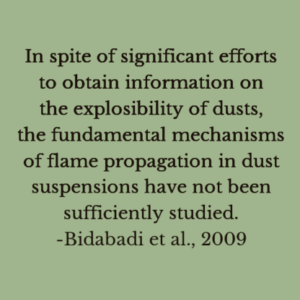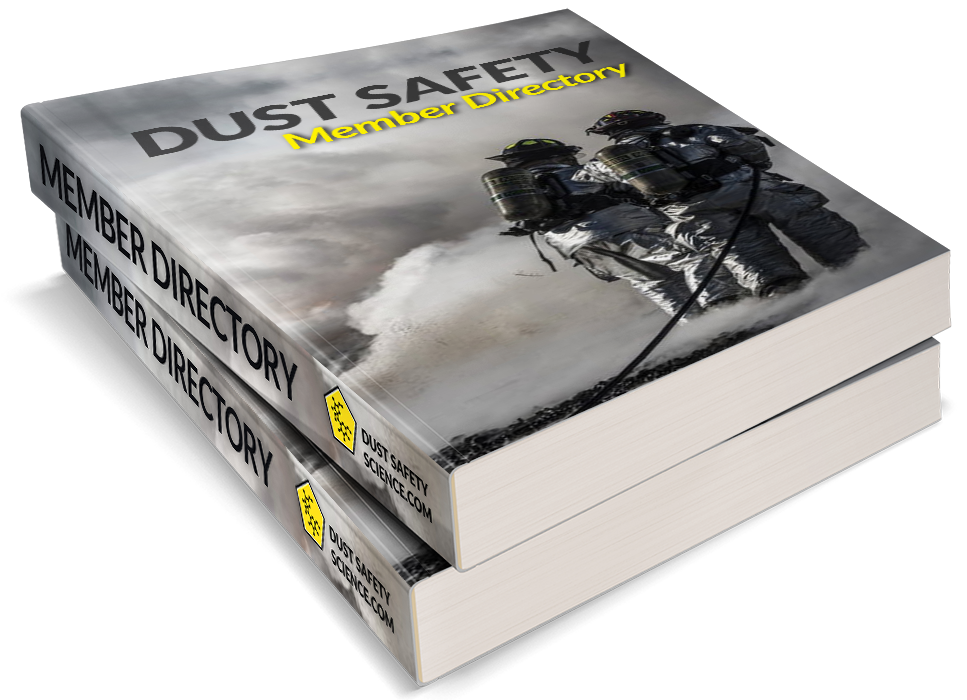1-Sentence-Summary: A mathematical model of dust flame propagation is developed and demonstrates the impact of particle vaporization, Lewis Number, and Damkohler Number on flame speed and structure.
Authors: M. Bidabadi, A. Haghiri, and A. Rahbari
Read in: Three Minutes
Favorite quote from the paper:

These authors develop a mathematical model of flame propagation in clouds of micro-organic particles. The model assumes the dust flame has four different zones: a preheat zone, a vaporization zone, a reaction zone, and a post flame zone. The governing equations are analytically solved using a standard asymptotic solution method.
Model assumptions include equilibrium between gas and particle temperature, negligible radiation effects, and a one-step irreversible reaction. It is also assumed that dust concentration is high enough that diffusion flames around individual particles surround adjacent particles. For droplets this assumption was shown to be valid for equivalence ratios greater than 0.7 (see the textbook by Williams, 1985 and Seshadri et al., 1992).
Burning velocity from the model compares favorably to experimental data from the literature (Proust et al., 2006) and previous modeling results (Seshadri et al., 1992). The role of particle vaporization, Lewis number, and Damkohler number on flame structure and burning velocity is explored. Lewis number is defined as mass diffusion rate divided by thermal diffusion rate and Damkohler number is defined as chemical rate divided by vaporization rate.
Three of the main findings from this paper are:
- Inclusion of separate preheating and vaporization zones had considerable effect on flame speed in the analytical model.
- Flame speed increases with an increase in particle Lewis number
- Flame speed decreases with an increase in particle Damkohler number.
The following sections outline the main findings in more detail. The interested reader is encouraged to view the complete article at the link provided below.
Finding #1: Particle vaporization plays an important role in dust flame propagation
The authors compare the current model to the results of Seshadri et al., 1992, published previously in the literature. In the previous model the “initiation of vaporization” was ignored and a three zone model was used. In the current approach it is assumed that the particles must heat up sufficiently prior to vaporization occurring.
At fixed particle size and Lewis number both models show an increase in flame speed as the nominal equivalence ratio increases in the range of 1.0 to 6.0. For 10 and 50 µm the four zone model shows slightly higher flame speeds than the three zone model. However, this trend is reversed at 100 µm, and the four zone model predicts a lower flame speed. These results appear to caused by competition between heating and vaporization.
Finding #2: An increase in Lewis number causes an increase in flame speed
The Lewis number is defined as the ratio of thermal diffusivity to mass diffusivity. In general, as the Lewis number increases so does the flame speed. For example, as the Lewis number increases from 0.75 to 1.5, flame speeds increase from 16 to 22 cm/s for 20 µm particles with a Damkohler number of 0.25 and equivalence ratio of 2.25.
The impact of Lewis number on the flame structure is also explored. Increasing the Lewis number decreases the amount of fuel diffusing into the preheat zone. This means that more fuel stays in the vaporization zone and is available for combustion reaction. This is coupled with enhanced heating due to the higher Lewis number, and both contribute to increased flame speed.
Finding #3: An increase in Damkohler number causes a decrease in flame speed.
In this work the Damkohler number is defined as the ratio of fuel reaction rate to vaporization rate. Results from the model demonstrate that an increase in Damkohler number from 0.25 to 1.0 causes a decrease in flame speed, although the effect is less than that due to the Lewis number. The decrease in vaporization rate compared to the reaction rate means that there is not enough fuel to supply the reaction rate. This is reinforced by the flame structure which shows less gaseous fuel in the vaporization and reaction zones with increased Damkohler number.
My Personal Take-Aways From
“The Effect of Lewis and Damkohler Numbers on the Flame Propagation through Micro-Organic Dust Particles”
This paper is a good introduction to analytical modeling methods for dust and droplet flame propagation. It also provides a good demonstration of how the fundamental heating, vaporization, and reaction processes affect heterogeneous flame propagation and flame structure. The interested reader is encouraged to review other modeling papers such as Ballal and Lefebvre, 1977, Seshadri et al., 1992, and Bidabadi and Rahbari, 2009.
An interesting but challenging contribution in this area would be to characterize the Lewis and Damkohler numbers for typical dusts found in processing industries. This would allow for results from analytical models to better translate into the process safety literature. Furthermore, this integration may provide future guidance for standards and protection methods in processing industries.
Full Citation: [bibtex file=references.bib key=Bidabadi2010a]
[otw_shortcode_button href=”http://www.sciencedirect.com/science/article/pii/S1290072909002130″ size=”medium” icon_position=”left” shape=”square”]> > Get The Article[/otw_shortcode_button]
